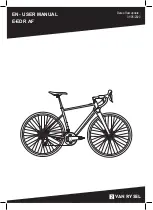
MY22H03 - 22_1.0_01.10.2021
14
Safety
2.1.2
Electric shock
2.1.2.1 Damage
Damaged chargers, cables and plug connectors
increase the risk of electric shock.
Check the charger, cable and plug connector
before each use. Never use a damaged
charger.
2.1.2.2 Water penetration
If water penetrates into the charger, there is a risk
of electric shock.
Never charge the battery outdoors.
2.1.2.3 Condensation
Condensation may form in the charger and battery
when the temperature changes from cold to hot,
causing a short circuit.
Wait until both charger and battery are at room
temperature before connecting them.
2.1.3
Risk of a crash
2.1.3.1 Incorrect quick release setting
Excessively high clamping force will damage the
quick release and cause it to lose its function.
Insufficient clamping force will result in
unfavourable transmission of force. This can
cause components to break. This will cause a
crash with injuries.
Never fasten a quick release using a tool (e.g.
hammer or pliers).
Only use the clamping lever with the specified
set clamping force.
2.1.3.2 Incorrect tightening torque
If a screw is fastened too tightly, it may break. If a
screw is not fastened enough, it may loosen. This
will cause a crash with injuries.
Always observe the indicated tightening torque
on the screw or in the
operating instructions
.
2.1.3.3 Incorrect component
The wheels are designed exclusively for use with
rim brakes or disc brakes. The wheel may break if
an incorrect brake is used. This will cause a crash
with injuries.
Never use the wheel with a different brake.
2.1.4
Risk of amputation
The brake disc in disc brakes is so sharp that it
can cause serious injuries to fingers if they are
inserted into the brake disc openings.
Always keep fingers well away from the
rotating brake discs.
2.1.5
Key breaking off
If you leave a key inserted when riding or
transporting the pedelec, it may break off or the
locking system may open accidentally.
Remove the key to the battery lock.
















































